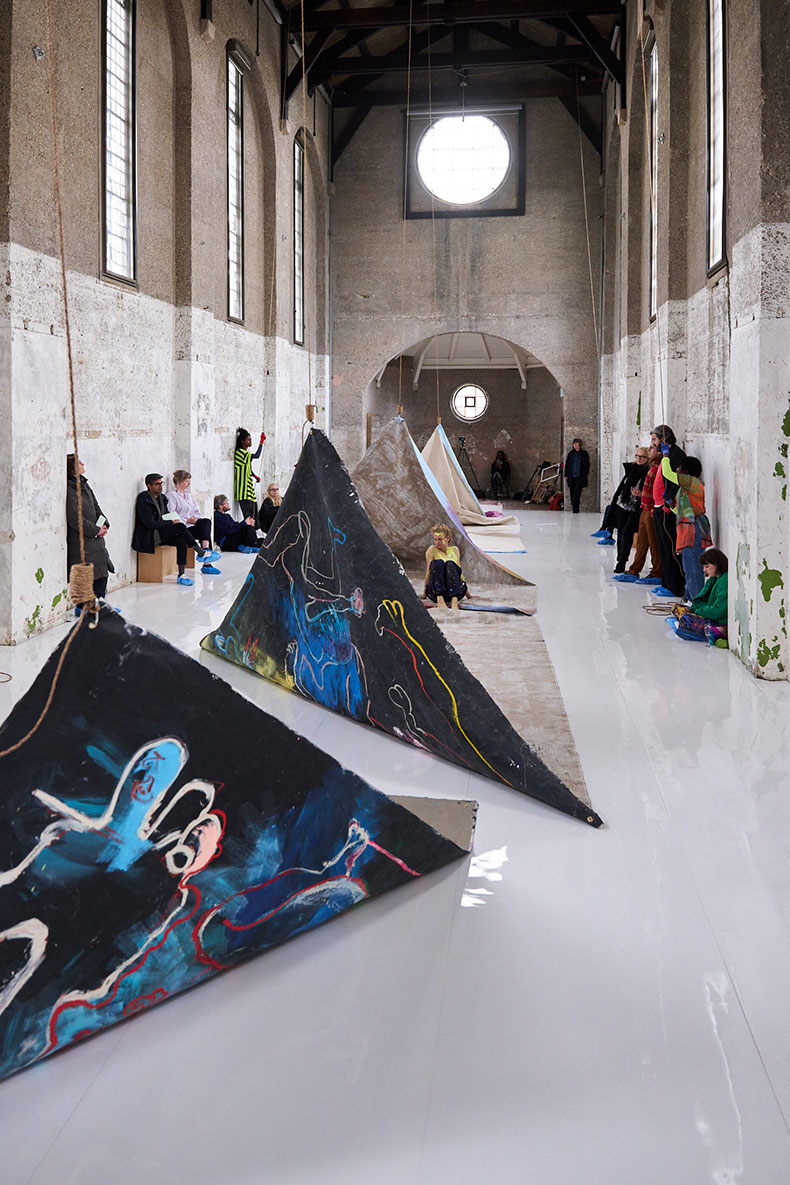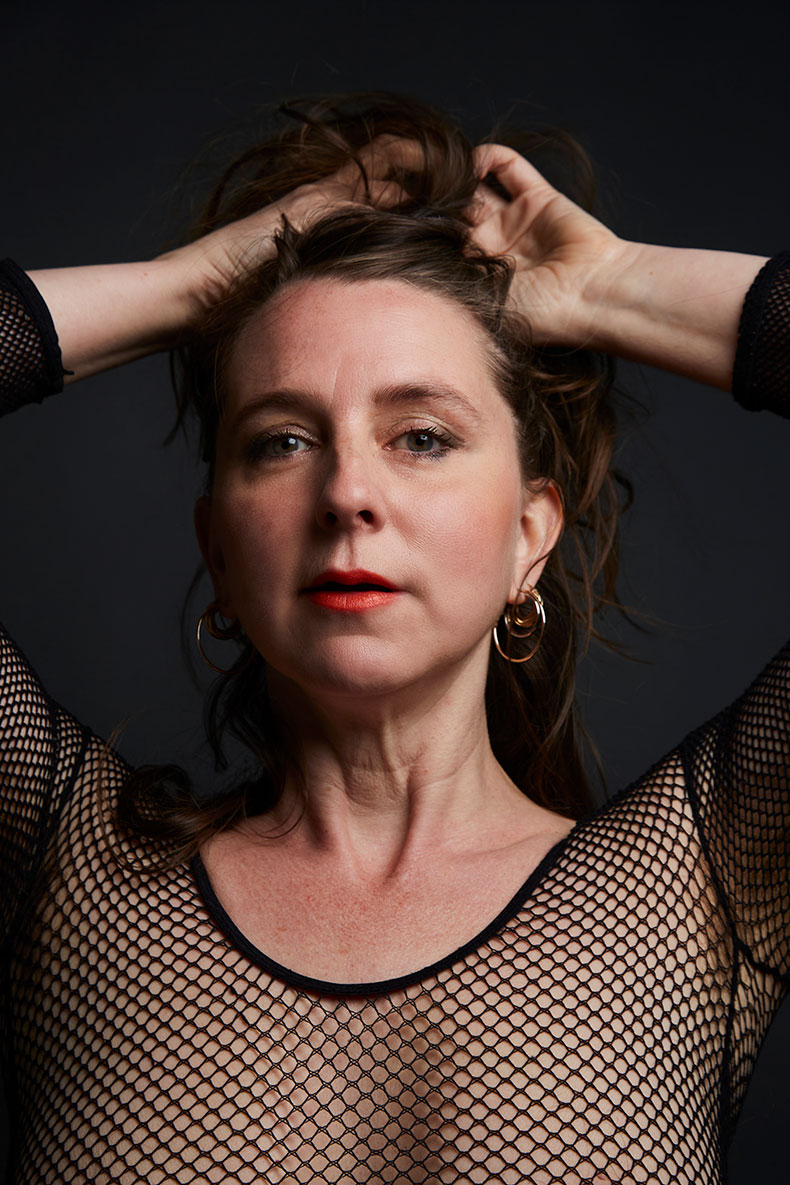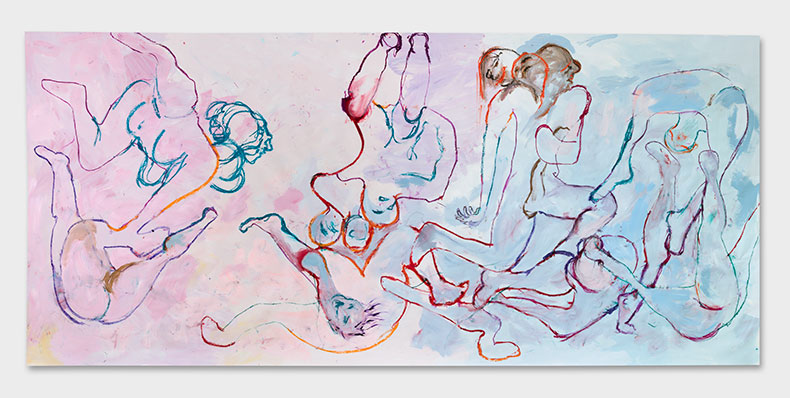Inside a cavernous, deconsecrated church in South London, a topless woman is kneeling on all fours while hands slather her in wet paint. A microphone is shoved into her face and she begins to read passages of art historical commentary on canonical white male artists, pulled from books on the likes of Titian, Vermeer and Pollock, the pages of which are strewn across the floor around her.
Florence Peake’s performance Factual Actual was first staged in 2021 at the National Gallery in London in response to the museum’s exhibition ‘Poussin and the Dance’. This latest iteration at Southwark Park Galleries’ Dilston Gallery (it will travel to Fruitmarket in Edinburgh and the Towner Eastbourne), is an evolution of the same concept, in which the artist expresses ideas about the ‘exchange between object and flesh’, how ‘classical painting represents women’ and the gap between what Peake calls the ‘fictional body and the empirical body’ – i.e. how we experience something versus how it actually is. ‘It happens a lot in performance, when I’ll feel like I was this phoenix rising from the flames or whatever and then I look at the documentation and it’s sort of limp in reality. That’s very scary to me,’ she says.
A performance of Factual Actual by Florence Peake at Dilston Gallery – Southwark Park Galleries, London in 2023. Performers: Temitope Ajose, Iris Yi Po Chan, Katye Coe, Eve Stainton, Rosalie Wahlfrid and Natifah White. Photo: © Misha Haller

In her work, that disconnect is often made visible through moments of chaos, such as when a performer in Factual Actual comes crashing through the space tangled up in stretcher bars, but it is also felt in a series of paintings and sculptures currently on display at Richard Saltoun Gallery in Mayfair. The body as depicted here is anything but stable – fragmented, twisted, bulging limbs tumble through space, while reclining sculptures made from loosely applied plaster bandages and wooden sticks appear either half-formed or decomposing. Messiness across mediums is a joyful rebellion for Peake – a way of pushing against traditional notions of femininity.
‘I feel great reverence towards the feminist performance art of the 1970s, where gesture was enough – this ephemeral, very transient act that can’t be captured – but I don’t want to fall in love with that,’ says Peake. ‘Like almost every young person who gets into performance art, that’s where I started: covering myself in paint and doing a sort of Yves Klein cliche thing. But now I’m wanting to take that gesture and turn it into something else so that it’s not stuck in its own history.’ All the works at Richard Saltoun are the products of performative actions. This fact doesn’t necessarily mean that they were made in front of an audience, but rather that they were painted, drawn and sculpted using choreographed movements, such as pressing her body onto the canvas. They are records of this process, but they also ‘take on their own autonomy,’ as Peake puts it.
Florence Peake. Photo: Christa Holka

Peake was born into a family of artists: she is the daughter of the late sculptor Phyllida Barlow, who died earlier this year, and the writer and painter Fabian Peake; all four of her siblings are artists. Watching Factual Actual, it’s impossible not to draw connections between Barlow’s performative approach to her materials and Peake’s use of canvases as both set and prop. Growing up, it was dance that allowed Peake to find her own form of creative expression. From the age of 11, she took herself to dance classes at Pineapple Studios in Covent Garden and later became interested in somatic movement practices, which focus on the internal relationship with the body. These practices continue to inform her work, helping to give shape to complex thoughts and emotions. She gets up from her chair throughout our conversation in her Somerset House studio to illustrate what she means through gestures ranging from a light flick of the hand to tripping forward and dangling upside down. Imprints of her other selves, records of different moments in time, clamber across three unstretched canvases tacked to the walls. These sit alongside ideas for future works that Peake has scribbled in pencil, including ‘ceramic wall’ and a new solo performance, because ‘I haven’t been performing much lately and I’m sick to death of my old performances.’
Factual Actual II (2020), Florence Peake. Courtesy Richard Saltoun Gallery; © the artist

Peake takes on a directorial role in Factual Actual, but some of her most provocative work has made use of her own body as well as that of her partner, Eve Stainton. Slug Horizons (2018), for example, involved the pair painting each other’s vulvas. In 2019, they were commissioned to make work for the Venice Biennale’s first-ever performance programme. The result was Apparition Apparition, which began with the artists crawling among the audience wearing nothing but thongs, inviting them to draw on their skin with felt-tip pens. The artists used their movements to evoke natural phenomena such as landslides and earthquakes; later, Peake jumped onto Stainton’s waist and thrust her breast into her partner’s mouth. Through these explicit acts, she sought to express queer intimacy, creativity and ways of being at a time of environmental devastation.
A performance of Factual Actual by Florence Peake at Dilston Gallery – Southwark Park Galleries, London in 2023. Performer: Temi Ajose. Photo: © Misha Haller.

Factual Actual may be less graphic than these previous works, but it makes similar use of a notably direct visual language. ‘There are times when I’ve been worried it all feels a bit basic [and] on the nose, particularly the part where Temi [one of the performers] is caught up in all these frames, crashing around the space like “I’m going to release myself from the frame, the patriarchy.” But for some reason it just works,’ says Peake. For an audience used to performance art that takes itself too seriously, the comedic tone of these scenes comes as a welcome relief. The familiarity of her imagery is also enjoyably inclusive, able to break down the barriers between ‘art’ and ‘viewer’. It is this non-hierarchical approach that allows Peake to extend and alter the work, to treat it as a non-precious thing that can be continuously moulded and reimagined.
‘Florence Peake: Enactment’ is at Richard Saltoun Gallery, London until 8 July.



